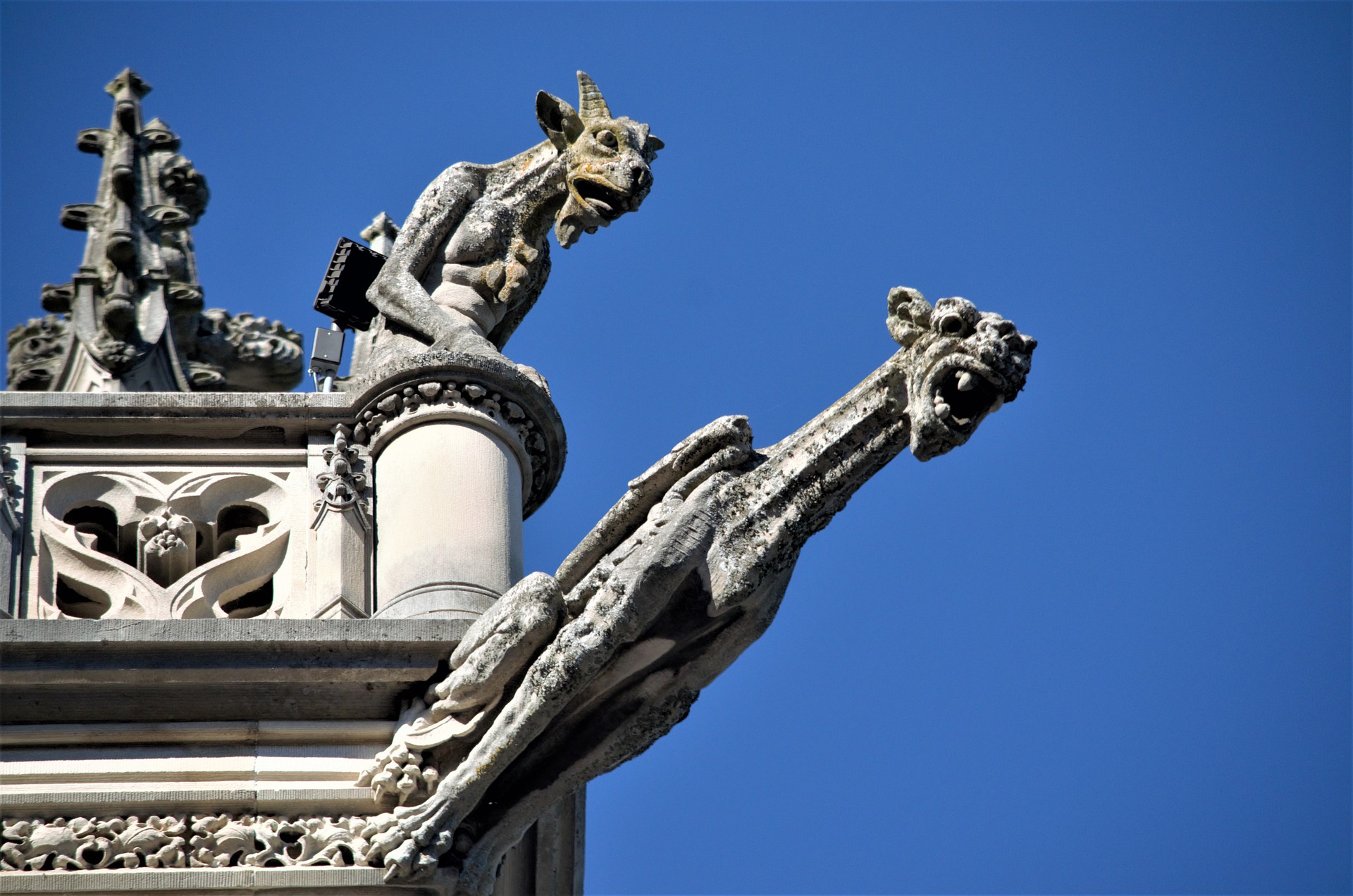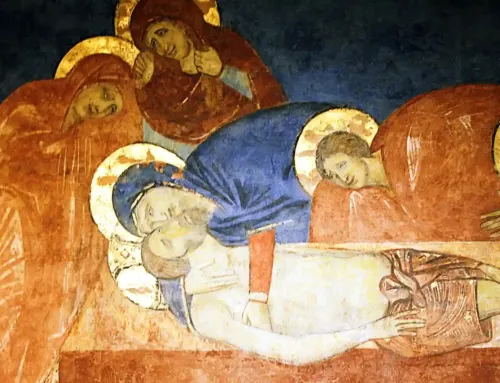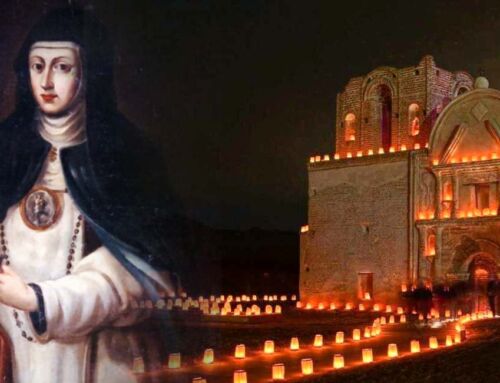The architects and stone masons who built the great medieval Gothic cathedrals would not have shared the opinion of the current Jesuit General that the devil is just a figment of our imagination.
(That whirring sound you hear is the Jesuits’ founder, St. Ignatius of Loyola, spinning in his grave.)
No, the medieval craftsmen were Catholics. They quite firmly believed in the complete doctrine of the faith which includes what the Church calls the Four Last Things (Heaven, Hell, Death, and Judgment).
And for that reason, those craftsmen also fashioned frightening little sculptures called gargoyles to put on their cathedrals. The gargoyles’ disquieting theology is simple: to scare the Beelzebub out of you!
There is good reason for this and some history behind it, so let me explain. The first thing to note is the name.

Origin of the Name
The word “gargoyle” comes from French folklore, which held that an evil dragon, called La Gargouille, once lived in the River Seine in Paris and caused havoc by setting things on fire, sinking ships, and eating all who opposed him – basically all the things mythical dragons do.
So the townsfolk, in turn, did the thing that all medieval societies did when they had a problem: they called in a saint.
The bishop of Rouen at the time, Saint Romain, came and lured his reptilian prey out of the water by dangling in front of it a condemned prisoner who was promised freedom if he would serve as bait – such a deal!
When the dragon lurched out of the river to feast on a nice juicy criminal, the courageous bishop subdued the menace by the Sign of the Cross. Well, that was easy, right?!
Today, the good bishop’s dragon-catching methods would be considered – mmm – ethically suspect, but I have it on good authority that the prisoner signed a release form absolving the diocese of all liability in the event of sudden death by devouring. (Even back then, bishops were careful.) Just kidding.
The legend goes on to say that in the wake of this glorious victory of the Cross over evil, the people slaughtered and burned the dragon. Unfortunately, the serpentine head and throat refused to be consumed by the flames; whereupon the people tacked up the remains of the beast prominently on the town’s cathedral as a token of thanksgiving to God and as a warning to any other dragons that thought they could mess with a saint.
So now you have the backstory for cathedral gargoyles. (Needless to say, the historical documentation for said incident is scarce.)
Messaging and Practicality
As per the legend, the practice of posting scary-looking creatures peering down at people from the eaves of cathedrals eventually caught on and became a standard part of Gothic cathedral design.
In essence, it was one of those raw medieval messaging techniques for reminding people of the real possibility of eternal damnation.
La Gargouille may have been a mythological creature, but in medieval shorthand, the beast was a direct metaphor for the devil, who is a very real snake-like creature (remember that little incident in the Garden of Eden?). He burns and breaks things and devours people more ferociously than the legendary river dweller in Paris. He’s not to be trifled with.
It is a common misunderstanding that gargoyles were placed on churches to ward off evil spirits, but that is not faith. It’s the type of superstition we commonly find in old legends. According to the Lord Himself, the devil doesn’t cast out the devil (Mt 12:26).
Then we come to the very practical reason for placing wide-mouthed statues around the exterior of a large, ornate building: gargoyles were used as rain spouts to funnel water off cathedral roofs in an architecturally clever way.
The English word “gurgle” (the sound of draining water) reflects this, as does the word for “throat” in all Romance languages. Its root is “garg-” or “gul-” in French, Italian, Spanish, Portuguese, and even Romanian!
The Ultimate Outsiders
The reason gargoyles were never placed inside cathedrals was that to enter into the Church meant to be saved. The angels that rebelled against God (see Revelation 12) were cast out of heaven and thus became the ultimate outsiders. Believers are saved by faith and by persevering in the community of faith.
Hence, gargoyles in various forms, are, to this day, perched on the outsides of cathedrals and other churches to exhort the viewer – believer and unbeliever alike – to take account of his own soul or risk being cast into the outer darkness. The Church’s exorcists can attest that the spiritual creatures of hell are much more frightening than even these scary carved statues.
Three Types of Gargoyles
As with any art form that spans centuries, there are many styles of gargoyle sculptures, but we can boil them down to three basic types, which highlight the truth of the Church’s teaching on sin and the Four Last Things:
Demons
This class of gargoyle is intended to fill the viewer with horror of the demonic world and to emphasize the reality of spiritual evil from which humans need to be protected by God’s grace. These kinds of gargoyles are purely evil-looking, resembling nothing in this world. In some cases they can have a sort of impotent or bored look to symbolize the banal nature of evil and the demons’ hopelessness for the possibility of redemption. That is an accurate theology of fallen angels. Here are a few:
Beasts (also called grotesques or chimeras)
These gargoyles come in the form of monstrous, wild, or unclean creatures of various body combinations, which in their own way reflect the chaos and distortions of sin. Beastly gargoyles usually jut directly out from the building as if in attack mode or aggressively menacing the viewer. God warned Cain that sin was “lurking at the door,” (Gen 4:7), and the grotesque gargoyles remind us of what happens when we ignore God’s warnings about sin. The overall theological message is that if virtue makes us more like angels, vice makes us more like beasts. Check these brutes out:
Damned souls
Most frightening of all, these types of gargoyles depict human souls literally fleeing from the Church in wide-eyed horror even as they are being transformed into hideous creatures themselves by their rejection of God. Some are pictured in flames; others are dressed as corrupt bishops (not Saint Romain!); and others are portrayed with recognizably human faces being overtaken by demonic characteristics. These messages hardly need explanation.
The Call to Repentance
The ancient practice of reminding people to think about their end (called Memento mori in Latin) needs to be vigorously restored in our Church and society.
The fundamental message of gargoyles is none other than the message of Christ and His apostles: “Repent and believe in the gospel” (Mk 1:15). Gargoyle images add a sense of urgency to the message. The time to repent is today, not tomorrow: “Now is the acceptable time, now is day of salvation!” (2 Cor 6:2).
Our virtual culture is so dominated by corrupt visual entertainment and pagan nonsense that it could use a stiff dose of gargoyle theology to remind us that repentance from sin is necessary to enter the Kingdom of heaven and that it can only happen in this life.
If we persist in sin, by the time we arrive at that final moment, it may be too late to avoid being devoured by the real Gargouille.
———-
[This article is a reproduction of the Sacred Windows Email Newsletter of 10/31/21, so it does not end with the regular Soul Work section. Please visit our Newsletter Archives.]




Wowsers. I love the faces of failed falling bored but vengeful human sin. Lol. Is that ok? Lol.
Mercii beaucoup très instructif!!L